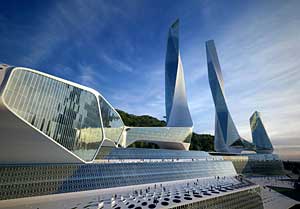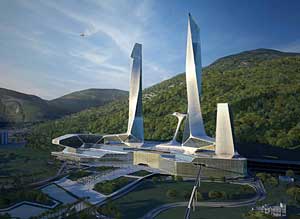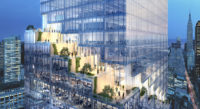During the 18th century, spice attracted both traders and pirates to Penang, an island harbor for ships on the Strait of Malacca in Malaysia. Now, government officials are hoping that 21st-century vanguard architecture and luxurious beachfront resorts will once again draw international visitors to the island—this time, investors and tourists. To aid in the effort, municipal authorities have tapped Asymptote Architecture to design a $7 billion, 256-acre mixed-use complex called Penang Global City Center (PGCC).


Lise Anne Couture and Hani Rashid, principals of the New York–based architecture firm, unveiled their design for the nearly 11-million-square-foot PGCC development in September. Their project takes the form of two sinuous, 60-story steel-and-glass-clad towers that reach skyward from a stagelike plinth. The towers will house luxury residential units and five-star hotels; the plinth will function as a public plaza and contain retail, a performing arts center, and a convention center.
“(Our project) is a harmonic assemblage of distinct historic and cultural references set against contemporary dynamics of fluidity, transformation, and flux,” Rashid says. Asymptote drew on Penang’s heritage of Chinese, Indian, and Arabian influences to create fenestration patterns inspired by arabesque motifs. “The towers allude to Asian mythical symbols and Islamic minarets,” he adds.
But the PGCC will also have a high-tech, sustainable sensibility: The project aims to be carbon-neutral. A central mechanical system will utilize trigeneration, including wind turbines and a thin-film photovoltaic facade.
Penang’s government expects to begin construction in 2008 and finish by 2012, but it is facing criticism about the site’s master plan, overseen by the Parisian firm Atelier Seraji. Opponents say that the PGCC fails to provide enough affordable housing and that it will create traffic congestion.





